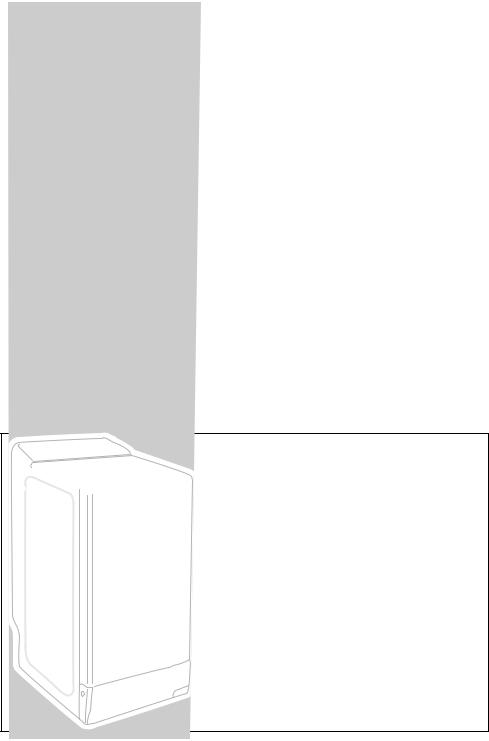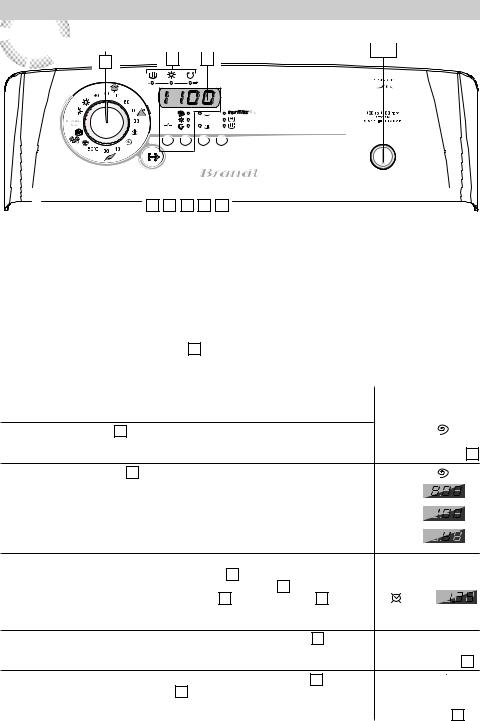BRANDT WTD1171A User Manual [fr]

WASHER-DRYER
 WTD1171A
WTD1171A
WTC1012A
INSTALLATION, OPERATING AND
MAINTENANCE INSTRUCTIONS

Contents
Safety /environment and savings ........................ |
2 |
Releasing, moving and levelling .......................... |
3 |
Connecting to the cold water supply .................. |
3 |
Draining away the waste water ............................ |
3 |
Connecting to the electricity supply .................... |
3 |
Sorting and checking your washing .................... |
4 |
Access to the machine’s drum ............................ |
4 |
Inserting your washing .......................................... |
4 |
Closing the drum .................................................... |
4 |
Cleaning products .................................................. |
4 |
Programming ........................................................ |
5-7 |
Details of the functions and the options .......... |
7-8 |
Changing a programme.......................................... |
9 |
Automatic safety systems .................................... |
9 |
Characteristics ........................................................ |
9 |
Running maintenance .......................................... |
10 |
Cleaning the pump and drying filters ................ |
10 |
Incidents that may arise ...................................... |
11 |
Textile care codes ................................................ |
11 |
Incidents notified on the display, |
|
which you can repair yourself .......................... |
12 |
BEFORE READING THESE INSTRUCTIONS, REMOVE THE ILLUSTRATED PAGES IN THE CENTRE OF THIS DOCUMENT
This machine is only designed for domestic use and to wash, rinse, spin and, depending on the model, dry machine-washable textiles.
You will find the following symbols used throughout this manual. They mean:
Safety instructions (for your machine and your washing), which must be observedAn electrical risk,
Important advice and information
Safety advice
In this manual, you will find the instructions required for the safety, installation and use of your machine and the relevant guarantees. Please keep these and pass them on if you sell the machine.
•Dispose of the packaging and of your worn-out machine (after rendering it unusable by removing the hoses, cutting the power cable and breaking the lock on the lid) in accordance with the prevailing regulations.
•For a new installation, the machine must be connected to the water supply with a new hose: the old hose must not be re-used.
•Do not let children play with the machine or the cleaning and maintenance products (water unsuitable for drinking, ingestion of the products, risk of physical harm, etc.). Keep pets away from the machine.
•Protect your property and your machine by checking the condition of the hoses regularly. Never use solvents, inflammable products, explosive products or aerosols near to or in your machine. Use the machine in a well-ventilated, frost-free area and do not use an extension lead or a multiple adapter.
•Switch off the power supply to your machine after use.
•If your machine should break down, call a qualified washing machine engineer.
•Only use your machine in accordance with the instructions in this manual. Only use washing and maintenance products approved for domestic machines.
For washer-dryers:
Some liquid detergent manufacturers may provide a plastic device, meant to be placed in the washing machine drum together with the laundry, for the gradual release of the liquid detergent. If you are using this device, please ensure that it is removed from the drum before you activate the drying cycle as its plastic material cannot withstand the high temperature of the drying process.
Environment and savings
•Fill your machine to the maximum. You thereby optimise your water and electricity consumption.
•Only programme a pre-wash when absolutely necessary: e.g. for heavily soiled sports or working clothes, etc.
•A programme with no pre-wash is sufficient for slightly or moderately soiled clothes.
•For slightly soiled clothes, select a short washing cycle (or an «Express» cycle, depending on the model).
•Gauge the amount of detergent according to the water hardness, the degree of soiling and the amount of washing. Always follow the manufacturer’s instructions on the detergent packets.
For washer-dryers:
•If you spin at high speed, little dampness will remain and you will therefore consume little electricity. Even synthetic textiles can be spun before drying.
•Choosing your drying time well also helps to save water and electricity.
•Avoid wasting water and electricity by not overdrying your laundry.
2

Releasing your machine
THE FOLLOWING OPERATIONS MUST BE PERFORMED BEFORE YOU USE THE MACHINE. FIGs 1 & 2
First of all remove the piece of expanded polystyrene from under the lid. (Keep the transport material: you will need it if you move).
Rear transport clamp FIG. 1 to
Unscrew the 6 screws using a No. 10 tube spanner or a straight-edged screwdriver.
Remove the clamp.
Free the power cable from the plastic holder clipping it to the transport clamp.
Plug the holes left by the clamp using the plugs supplied and re-screw the 4 external screws into the casing.
Front transport clamp FIG. 2 to
Unclip the plinth by pressing simultaneously on the side knobs and pulling them towards you.
Unscrew the screw holding the red plastic «front» clamp.
Remove the front clamp.
Plug the hole left by the clamp with the remaining plug.
Clip the plinth on again.
Moving and levelling
Setting on castors, moving
To move your machine, unclip and slide the castor release handle from right to left.
Your machine must not still be on its castors when in operation.
Check that it is plumb and stable to avoid vibration during spinning.
Levelling FIG. 6
-Set your machine on its castors.
-Unscrew the two screws with a straightedged screwdriver.
-Level the machine by adjusting the two feet using a flat spanner or a pair of pliers.
-Set the machine back on the floor by sliding the castor release lever to check the chocking.
-If the machine is correctly level, retighten the two locking screws.
To align your machine with your units, you can break off the fixing hooks for the hoses.
Take care not to squash the hoses!
If you cannot avoid installing the machine on a carpeted floor, adjust the feet so as to leave a large gap for ventilation.
Connecting your machine
Connecting to the cold water supply (FIG. 5)
Your washing machine can be connected to any cold water pipe. Connect the supply hose provided to a threaded 20x27 Ø tap (3/4 BSP) not forgetting to insert the seal supplied (depending on the model, the hose may already be fitted with a seal).
Water pressure may vary from 0.1 to 1 MPa (1 10 bars). If the pressure is high, please provide a pressure regulator. Your water supplier can provide the necessary advice.
Draining away the waste water (FIG. 5)
NB: Ensure that the drain hose is tied firmly in place with cord, etc. to avoid a possible flood. In all cases, the height of the drain hose bracket must be between 0.80 m minimum and 1.10 m maximum above the floor. The hose must be fastened to avoid it breaking and its opening must be above the surface of the water being drained away.
Connecting to the electrical supply (FIG. 5)
Please refer to the «Characteristics» section. The socket must be easily accessible but out of children’s reach.
The installation must conform to the country’s regulations, in particular as regards earthing requirements and installation in showerrooms. The machine must be earthed.
Never use an extension lead or a multiple adapter for connecting to the socket.
* We cannot be held responsible for any incident caused by poor earthing of the machine or poor electrical installation.
The machine must be switched off (in the «Stop» position) when connecting to the electrical supply.
3

Preparing your washing
Failure to observe the following advice can cause severe and even irremediable damage (damage to the drum, torn washing, etc.) and rescinds the guarantee.
Sorting your washing
•Ensure that all your washing is machinewashable: check the labels on your washing (type, temperature, type of cleaning, etc.).
•Ensure that your coloureds do not run. •When washing a mixed load, use the
washing programme for the most delicate textiles in the mix.
Checking your washing
•Empty the pockets and close any zips and press-studs.
•Remove any curtain hooks or place your curtains and any small items of laundry (ribbons, handkerchiefs, etc.) in a net bag. Button up pillowcases, etc.
•Remove any poorly attached buttons, pins and hooks.
Access to the machine’s drum (FIGs. 3 - 4)
•Proceed as follows:
•Check that the machine is switched off. •Open the machine’s door (FIG. 4).
•Press the button on the front flap. (FIG. 3 )
Loading your washing
•For optimum washing performance, place the previously sorted and folded washing in the drum, distributing it evenly without heaping it up. Mix large and small items to obtain optimum spin-drying without unbalancing.
•Check that no items have fallen down the side the drum.
Closing the drum
•Close the drum using both hands, ensuring that the button returns to the correct position. The coloured section must be visible (FIG. 3 ).
CHECK THAT NO WASHING IS CAUGHT BETWEEN THE TWO FLAPS.
Checking your washing before drying
(only for washer-dryer models)
Your washing is composed of different types of fibres, of different origins: the various items may therefore behave very differently during drying.
As a general rule, all machine-washable textiles can be dried in a domestic tumble dryer except for:
-Woollens, silks, net curtains, plasticised fabrics, tights and nylon stockings
-Chlorofibres (Thermolactyl* for example)
* Registered trademark
-Foam, plastic or rubber-coated items or any items with a framework that could become detached, bulky items (duvets, eiderdowns, etc.)
-Washing that has not been spun
-Items washed with chemical products.
You must however avoid drying light textiles and thick cotton textiles at the same time. The weight of the thick cotton textiles can crease lighter ones.
It is better to dry textiles not guaranteed colourfast separately.
Washing products (Fig 10)
Filling the detergent dispensers
Pre-wash dispenser (powder  )
)

 Wash dispenser (powder
Wash dispenser (powder  or liquid
or liquid )
)
The «WASH» dispenser may contain either powder or liquid but liquid detergents should not be used with programmes WITH pre-wash.
cl Bleach: bleach can be used as a
disinfecting or bleaching agent. Concentrated bleach must be diluted.
 Softener: Concentrated softener should be diluted with warm water.
Softener: Concentrated softener should be diluted with warm water.
Loading the washing products
Follow the dosage instructions on the pack. Warning: these are generally recommended for a full load of washing. Adapt the amounts to suit the condition of your washing.
Too much detergent can cause foam. An excessive amount of foam reduces your machine’s performance and increases the washing time and water consumption.
We recommend the use of "low suds" detergent on your washing machine.
Do not forget to reduce the amounts when using concentrated detergents. See the instructions on the pack.
Reduce the product amounts by 10%
When the water is soft, when your washing is only slightly soiled and there is only a small amount. When the washing programme is short.
Detergents for woollens and delicate fabrics
Use an appropriate detergent for washing these textiles (avoid putting the detergent directly into the drum because some of these products can attack the metal).
4

Programming
Cycle progress |
|
|
|
|
|
Display |
On/Off |
|||||
|
|
|
|
|||||||||
Type of washing and temperature |
|
|
|
|
|
|
|
|
|
|
|
|
|
|
|
|
|
|
|
|
I /O |
||||
|
|
|
|
|
|
|
|
|
|
|||
|
|
|
|
|
|
|
|
|
||||
1 |
B |
A |
|
|
|
|
|
|
|
|
|
|
|
|
|
|
|
|
|
|
|
|
|
|
|
|
|
|
|
|
|
|
|
|
|
|
|
|
|
|
|
|
|
|
|
|
|
|
|
|
|
|
|
|
|
|
|
|
|
|
|
|
|
|
|
|
|
|
|
|
|
|
|
|
|
|
|
|
|
2 |
|
R |
|
3 |
|
4 |
|
5 |
|
|
|
|
|
|||||
|
|
|
|
|
|
|
|
|
|
|
|
|
|
||||||||||
Start/Pause: press briefly |
|
|
|
|
|
|
|
|
|
|
|
|
|
|
|
|
|
|
|
|
Sleekare, Eco, Intensive wash options |
||
|
|
|
|
|
|
|
|
|
|
|
|
|
|
|
|
|
|||||||
|
|
|
|
|
|
|
|
|
|
|
|
|
|
|
|
|
|
|
|
||||
|
Cancelled: long press |
|
|
|
|
|
|
|
|
|
|
|
|
|
|
|
|
|
|
|
Prewash, Rinse Plus options |
||
|
|
|
|
|
|
|
|
|
|
|
|
|
|
|
|
|
|
|
|
||||
|
|
|
|
|
|
|
|
|
|
|
|
|
|
|
|
|
|
|
|
|
|||
|
Spin speed, drying time |
|
|
|
|
|
|
|
|
|
|
|
|
|
|
||||||||
|
|
|
|
|
|
|
Selector for the spin speed, drying and |
||||||||||||||||
|
|
|
|
|
|
|
|
||||||||||||||||
|
and delay start setting |
|
|
|
delay start functions |
||||||||||||||||||
Apart from the «On/Off» button, all the buttons are sensitive and therefore do not remain depressed. During programming, all the buttons except for «Start/Pause» can be kept depressed but, for more precise adjustment, we recommend that you operate them with a series of brief presses. You should operate the «Start/Pause» by pressing it briefly except when cancelling the programme, in which case it should be kept depressed.
(*) Details of the function are provided in the following pages.
If one of the cycle progress lights B is lit when you switch on, cancel before carrying out any other operation.
Warning: the «On/Off» button cannot cancel a programme.
Full programming (combined with drying or not) |
Lights and/or display |
|||||||||
• Press in the «On/Off» button |
|
(1). |
|
|
|
|
|
|
|
|
I /O |
|
|
|
|
|
|
|
|
||
• Turn the selector 1 to select the programme and the washing |
|
|
|
Light |
||||||
temperature. The machine proposes the recommended spin speed for |
|
|
+ spin speed |
|||||||
the type of textile selected. |
recommended on A |
|||||||||
• Use the setting button R : |
|
|
|
Light |
||||||
- Either to alter the proposed spin speed. (If you programme for |
|
+ e.g.: |
|
|
|
|
||||
|
|
|
|
|
||||||
sequenced drying, select the highest spin speed possible) |
|
|
|
|||||||
|
|
|
|
|
|
|
|
|||
- Or to select drip dry. |
|
|
|
or |
|
|
|
|
||
|
|
|
|
|
|
|
||||
The cycle will finish with a gentle spin at 100 rpm |
|
|
|
|
|
|||||
|
|
|
|
|
|
|
|
|||
- Or to select stopping with the drum full of water. |
|
|
|
or |
|
|
|
|
||
|
|
|
|
|
|
|
||||
The machine will stop with the drum full of water before the final spin. |
|
|
|
|
|
|||||
|
|
|
|
|
|
|
|
|||
• Select, or not, any of the following options: |
|
|
|
|
|
|
|
|
||
- «Prewash» and/or «Rinse Plus» via button 4 |
+ selected options |
|||||||||
- «Sleekare» and/or «ECO» and «Intensive» via button 5 |
|
|
|
|
|
|
|
|
||
- Subsequent immediate drying via button 3 then, via button R , set the |
+ |
|
|
+ e.g. |
|
|
|
|||
|
|
|
|
|
||||||
desired drying time (for the washing load to be dried, see the Programmes |
|
|
|
|
|
|
|
|
||
table) |
|
|
|
|
|
|
|
|
||
•Select immediate start by pressing the «Start/Pause» button 2 ...
•... Or select a start delayed by 1 - 19 hours by using button 3 to select this option and then using button R to set the period of the delay.
Light 
+ display of washing
time remaining A
Light 
+ display of time remaining before the cycle starts A
5
